Response Time 3 Hours , Response Rate 100%
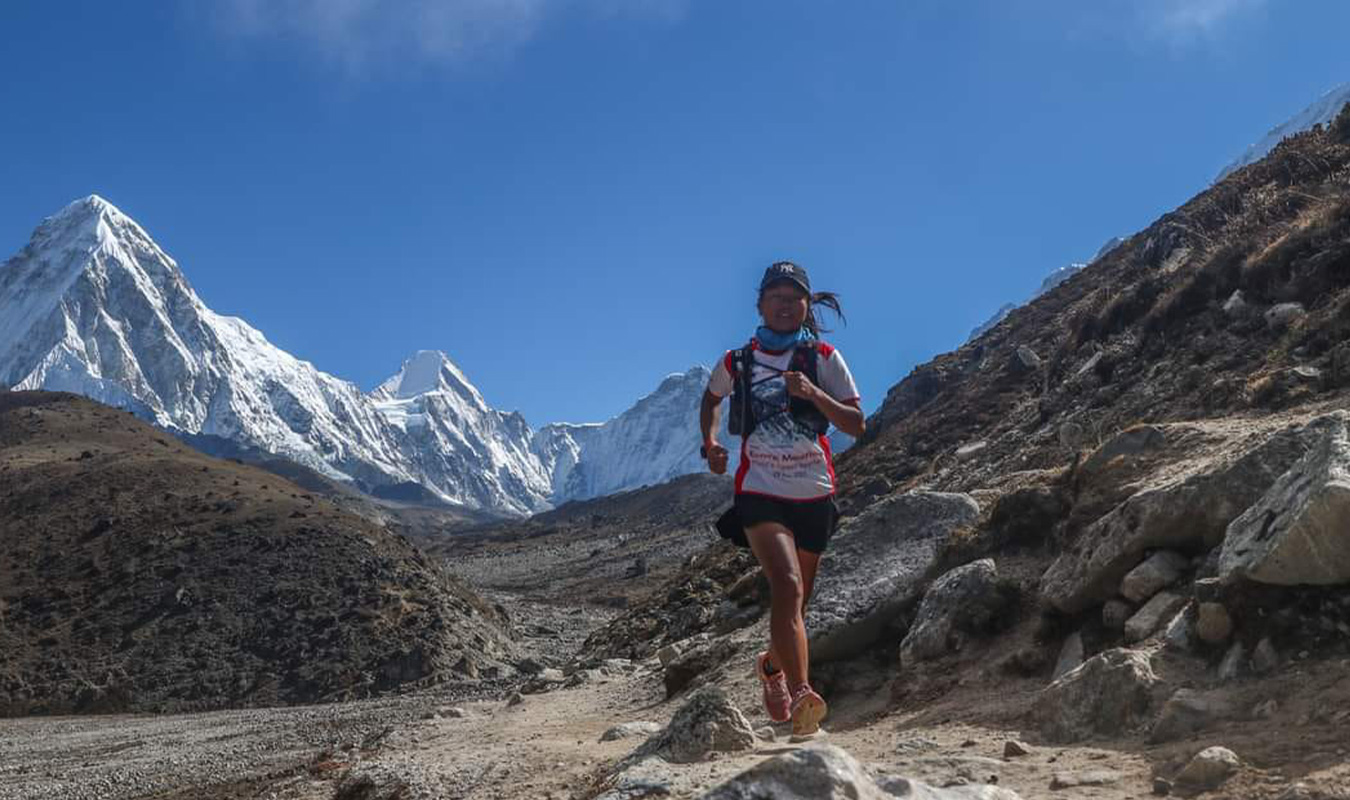
The Tenzing Hillary Everest Marathon 2026 is usually held on May 29th to commemorate the first successful ascent of Mount Everest by Sir Edmund Hillary and Tenzing Norgay Sherpa on May 29, 1953. This marathon begins at the Everest Base Camp (5364 meters/17,598 feet) and finishes in Namche Bazaar (3446 meters/11,306 feet) in the Khumbu region of Nepal.
Participants from around the world come to challenge themselves in this high-altitude race, navigating challenging terrain and facing the thin air characteristic of such elevations. The event not only serves as a sporting challenge but also as a tribute to the pioneering spirit of Sir Edmund Hillary and Tenzing Norgay.
To participate in the Tenzing Hillary Everest Marathon, individuals typically need to register through the official website or affiliated agencies, paying the necessary fees, and undergoing a fitness assessment to ensure they can cope with the demands of running at high altitudes.
Being a physically demanding and logistically complex event, participants often need to undergo proper acclimatization before the marathon. Many choose to trek to Everest Base Camp prior to the race to adapt to the high altitude.
The importance of participating in such an event goes beyond personal achievement. It offers a unique opportunity to experience the breathtaking Himalayan landscapes, challenge personal limits, and immerse oneself in the rich Sherpa culture. Additionally, the marathon often serves as a fundraiser for various charitable causes, contributing to the local communities in the Everest region.
Event Date: May 29, 2026 – held every year on the anniversary of the first Everest summit.
Starting Point: Everest Base Camp (5,364 meters / 17,598 ft).
Finish Line: Namche Bazaar (3,440 meters / 11,286 ft).
Race Categories:
Terrain: High-altitude trails, rocky paths, glacial moraines, suspension bridges, and Sherpa villages.
Altitude Challenge: The race begins at over 5,300 meters, making it the world’s highest marathon.
Participants: International athletes, professional marathoners, adventure seekers, and trekkers.
Cultural Experience: Passes through Sherpa villages, monasteries, and scenic Himalayan landscapes.
Commemoration: Honors Sir Edmund Hillary and Tenzing Norgay’s first ascent of Everest in 1953.
Thinking about joining the world’s highest race? Here’s what you need to know about Everest Marathon registration 2026 and who is eligible to participate:
How to Register: Interested runners can complete their Everest Marathon registration 2026 through Sole Encounters Adventur in Nepal. Early booking is recommended as slots are limited.
Eligibility Requirements:
How to Join Everest Marathon: Participants must trek to Everest Base Camp as part of the acclimatization program before race day. This ensures runners are physically ready to handle the altitude.
International Participation: Runners from across the globe are welcome to participate in Everest Marathon Nepal, making it a truly global sporting event.
Tenzing Hillary Marathon Eligibility Criteria: Suitable for experienced runners, endurance athletes, and adventure enthusiasts who are physically and mentally prepared for extreme high-altitude conditions.
Planning your adventure for the Tenzing Hillary Everest Marathon 2026? Understanding the Everest Marathon cost 2026 and available packages is crucial for a smooth experience.
Everest Marathon Cost 2026:
Everest Marathon Packages Nepal:
Standard Package: Includes race registration, trekking support, tea-house accommodations, meals, and Lukla-Kathmandu flights.
Deluxe Package: Adds luxury lodges, personalized guide support, and helicopter transfer options.
Custom Packages: Tailored itineraries for international runners or adventure groups, including pre-marathon training treks.
Travel Packages for Everest Marathon 2026:
Packages typically include airport transfers, domestic flights (Kathmandu → Lukla → Kathmandu), trekking guides, porters, and permits.
Some packages combine the marathon with other Himalayan adventures or sightseeing tours in Nepal.
Why Book a Package:
The Tenzing Hillary Everest Marathon 2026 is not just a test of endurance; it’s an unforgettable journey through the heart of the Khumbu region. Participants can choose from multiple race categories, each offering unique challenges and breathtaking Himalayan scenery.
Half Marathon – 21K:
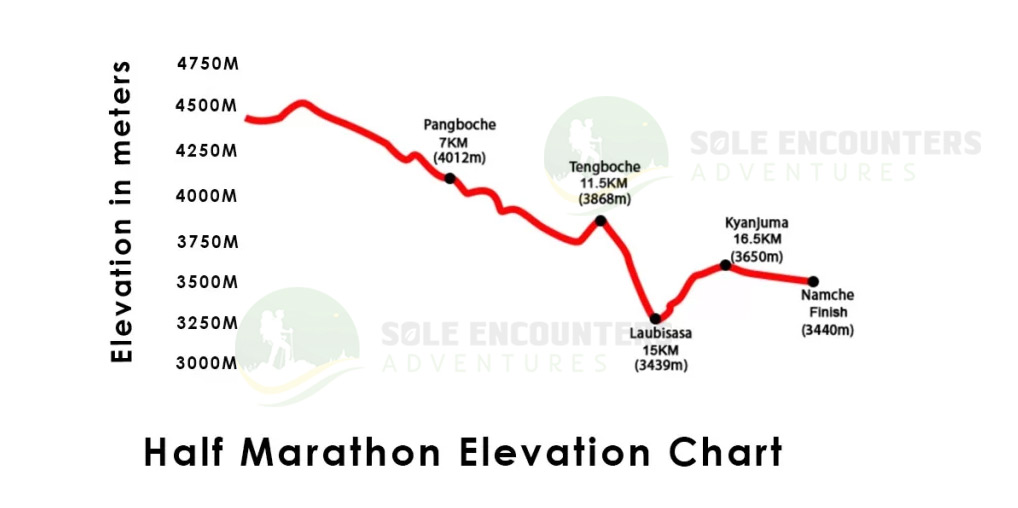
Full Marathon – 42K:
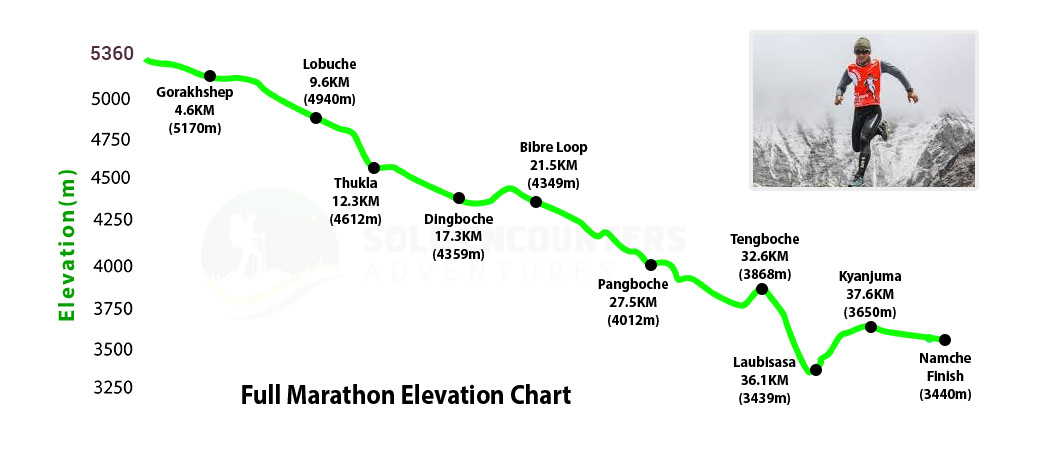
Ultra Marathon – 70K:
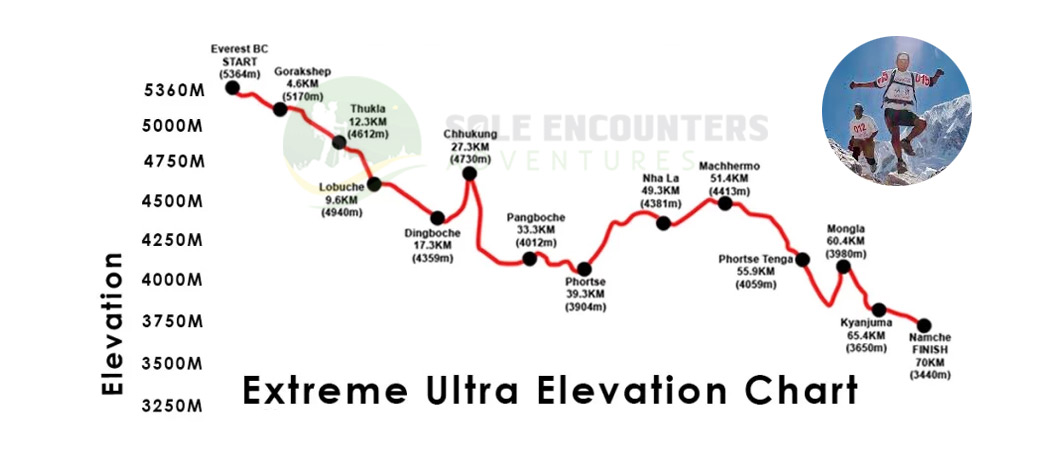
Key Route Features for All Distances:
Preparation Note: Proper acclimatization and physical training are essential due to the high-altitude challenges across all race distances.
Before starting the Tenzing Hillary Everest Marathon, participants typically stay in the Everest region of Nepal, often in the village of Lukla or at Everest Base Camp itself, depending on the specific logistics of the event. Here's a breakdown:
Kathmandu:
Most participants arrive in Kathmandu, the capital city of Nepal, where they may spend a day or two for logistical preparations and final arrangements.
Lukla:
Lukla is a popular starting point for treks to Everest Base Camp and the Tenzing Hillary Everest Marathon. Participants often take a short domestic flight from Kathmandu to Lukla, which is known for its challenging airstrip. Lukla serves as the gateway to the Everest region.
Namche Bazaar:
Namche Bazaar is a key acclimatization stop and the ending point of the marathon. Participants may stay here for a few days to adjust to the high altitude before the marathon begins. It's a vibrant Sherpa town with facilities for trekkers and climbers.
Everest Base Camp:
Everest Base Camp (EBC) is where the Tenzing Hillary Everest Marathon starts. Participants often spend a few days at EBC to acclimatize further and to experience the unique atmosphere of the Everest climbing season. EBC is at an elevation of around 5364 meters (17,598 feet).
Accommodations in these areas range from basic teahouses to more comfortable lodges, depending on the specific route and package chosen by the participants. The trek to Everest Base Camp itself is a stunning journey through the Khumbu Valley, passing through picturesque Sherpa villages and offering breathtaking views of the Himalayas.
It's important to note that the specifics of accommodation can vary based on the organizer of the event, and participants usually arrange their stay as part of the overall marathon package, which may include lodging, meals, permits, and logistical support during the entire journey.
If you are considering participating in the Tenzing Hillary Everest Marathon or any high-altitude marathon, it is crucial to undergo thorough physical training, acclimatization, and preparation. Additionally, understanding the significance of the event, its history, and the cultural context adds to the overall experience of the journey. Always stay informed about the latest updates and requirements for participation through official channels
The Tenzing Hillary Everest Marathon is an extraordinary adventure that presents participants with a range of unique highlights. Here are some of the main features that make this trip stand out:
Stunning Himalayan Landscapes:
The marathon route takes participants through the heart of the Khumbu region, offering panoramic views of some of the world's highest peaks, including Mount Everest, Lhotse, Nuptse, and Ama Dablam.
Everest Base Camp Start:
The race commences at Everest Base Camp, providing participants with the opportunity to stand at the iconic base of the world's highest mountain.
High-Altitude Challenge:
The marathon is recognized as one of the highest in the world, with elevations exceeding 5,000 meters (16,404 feet). The thin air and challenging terrain make it a physically demanding and mentally exhilarating experience.
Cultural Immersion:
Participants have the chance to immerse themselves in Sherpa culture, passing through traditional villages like Namche Bazaar and interacting with local communities along the route.
Acclimatization Trek:
Many participants choose to undertake an acclimatization trek to Everest Base Camp before the marathon, providing a unique opportunity to gradually adjust to the high altitude while enjoying the trekking experience.
Historical Significance:
The marathon is held annually to commemorate the first successful ascent of Mount Everest by Sir Edmund Hillary and Tenzing Norgay Sherpa on May 29, 1953, adding a historical and symbolic dimension to the event.
Community Impact:
The marathon often serves as a platform for fundraising and contributing to local communities in the Everest region. Participants may engage in philanthropic activities to support projects benefiting the local population.
International Participation:
Adventurers from around the globe come together to take part in this iconic race, fostering a sense of camaraderie and shared achievement among participants with diverse backgrounds and motivations.
Personal Achievement:
Completing the Tenzing Hillary Everest Marathon is a remarkable personal accomplishment, with participants overcoming physical and mental challenges in one of the most extreme environments on Earth.
Unique Finish in Namche Bazaar:
The marathon concludes in Namche Bazaar, a picturesque Sherpa town, providing a memorable and culturally rich endpoint for the challenging race.
These highlights collectively contribute to the allure and prestige of the Tenzing Hillary Everest Marathon, making it an unforgettable adventure for those seeking the ultimate test of endurance and exploration amidst the Himalayan splendor
Upon arrival at Tribhuvan International Airport (TIA), Kathmandu, Sole Encounters Trekking will assist you in transferring to your hotel.
After settling in, meet with your guide for a trip briefing followed by a welcome dinner. Explore Kathmandu Valley, a cultural and political hub surrounded by mountains. Visit landmarks like Swayambhunath Stupa and Pashupatinath Temple. The valley offers a rich cultural heritage, including the Kathmandu Durbar Square. Experience natural beauty with hills and mountains, including Shivapuri National Park, perfect for hiking.
Please note: Due to potential traffic congestion at TIA, there are changes in domestic flight operations.
During peak seasons, starting from either 23rd September or 15th March, visitors may travel to Ramechhap for flights to Lukla. Ramechhap, approximately a 6-hour drive from Kathmandu, provides basic accommodations like tented camps and local guesthouses. Ensure you receive updates from your tour company for the latest information.
Certainly! The journey from Kathmandu to Lukla and the subsequent trek to Phakding is the initial leg of the Tenzing Hillary Everest Marathon adventure. Here are the details:
Day 1: Fly from Kathmandu to Lukla (2,860 m):
The journey begins in Kathmandu, where participants take a scenic domestic flight to Lukla, a town known for its challenging airstrip. The flight itself provides breathtaking views of the Himalayas, including Mount Everest, weather permitting.
Lukla is the gateway to the Everest region and serves as the starting point for treks and the Tenzing Hillary Everest Marathon.
Day 2: Trek from Lukla to Phakding (2,652 m) - 3 to 4 hours:
The trek from Lukla to Phakding is a relatively short but picturesque walk that sets the tone for the adventure.
The trail descends from Lukla, passing through charming Sherpa villages, prayer flags, and mani walls. Participants get a glimpse of local culture and traditions.
The route follows the Dudh Koshi River, offering serene views of the river and surrounding landscapes.
Phakding, situated at an altitude of 2,652 meters, provides a comfortable stop for the night. Teahouses in Phakding offer basic accommodation and meals for trekkers.
Accommodation:
Participants usually stay in teahouses in Phakding. Teahouses are basic lodges that provide a cozy place to rest, simple meals, and a chance to interact with fellow trekkers.
Day 5: Trek from Namche Bazaar to Tengboche (3,860 m) - 5 to 6 hours:
Day 6: Trek from Tengboche to Dingboche (4,410 m) - 6 hours:
Day 7: Dingboche Acclimatization Day (4,410m):
This acclimatization day is strategically placed to ensure the well-being of participants, allowing them to acclimate effectively before continuing the journey towards Everest Base Camp. The flexibility in acclimatization activities accommodates individual needs and enhances the overall trekking experience
Day 8: Trek from Dingboche to Lobuche (4,940 m) - 5 to 6 hours:
Day 9: Trek from Lobuche to Gorak Shep (5,165m) - 4 Hours:
Trekkers should be prepared for basic amenities in Gorak Shep, including shared accommodations and simple toilet facilities.
Acclimatization to Kala Patthar is optional but highly recommended for those seeking breathtaking views and additional acclimatization.
As trekkers reach Gorak Shep, they are on the threshold of the Everest Base Camp, with the iconic Kala Patthar providing a vantage point to marvel at the world's highest peaks. The journey's challenges and rewards converge in this final phase before the ultimate destination
Day 10: Hike from Gorak Shep to Everest Base Camp (5,364m):
Reflecting on Your Journey:
Finally! The day of the Marathon arrives. You will be starting this race early morning. Running through the spectacular Khumbu Valley you will witness a stunning sunrise while you breathe through the thin air. You will have one of the most surreal experiences here
Everest Marathon Day:
Trek to Phakding (2,660m):
This final day encapsulates the triumph of your journey, providing an opportunity for gratitude, celebration, and reflection before returning to Kathmandu.
The Everest Marathon is held annually on May 29 to commemorate the historic first ascent of Mount Everest by Sir Edmund Hillary and Tenzing Norgay in 1953. This date honors their achievement and celebrates Nepal’s mountaineering heritage.
The Everest Marathon is considered one of the world’s toughest marathons due to extreme high-altitude conditions, rugged terrain, and variable Himalayan weather. Participants face steep descents, rocky trails, suspension bridges, and altitude starting from 5,364 meters (Everest Base Camp). Proper training and acclimatization are essential.
The race is open to international and local runners who meet the eligibility criteria:
Minimum age: 18 years
Good physical fitness and prior long-distance running experience recommended
Medical clearance for high-altitude activity
Runners of all levels can participate in different race categories (21K, 42K, 70K), but preparation is key.
Yes, all participants must obtain permits for Everest Marathon Nepal. This includes:
TIMS card (Trekkers’ Information Management System)
Sagarmatha National Park entry permit
Official marathon registration with the organizing committee
Packages with local operators like Sole Encounters Trekking include all permits to ensure a hassle-free experience.
Follow Everest Marathon training tips for high-altitude endurance
Acclimatize gradually with pre-marathon treks
Focus on nutrition, hydration, and mental readiness
Preparing for the Everest Base Camp (EBC) Trek and Everest Marathon requires careful consideration of the equipment you'll need to ensure comfort, safety, and success in the challenging Himalayan environment. Here's a comprehensive list of essential items for both the trek and the marathon:
1. Trekking Gear:
2. Clothing:
3. Headgear:
4. Marathon-Specific Gear:
5. Accessories:
6. Personal Items:
7. Optional Items:
Important Tips:
Always adapt your packing list based on the specific time of year and conditions during your trek and marathon. Consult with your tour operator for any specific recommendations and check for updated gear lists.
The Everest Marathon is an exceptionally challenging race due to its high-altitude setting, with the finish line located at Everest Base Camp (5,364 meters/17,598 feet). Participants should possess a high level of fitness and some degree of high-altitude experience to tackle the demanding course. Here's an overview of the fitness level and high-altitude experiences required:
1. Fitness Level:
2. High Altitude Experience:
3. Marathon Level:
Important Considerations:
The Everest Marathon is an extraordinary adventure that demands physical fitness, mental resilience, and prior high-altitude exposure. Proper preparation, including targeted training, altitude acclimatization, and understanding the unique challenges of the course, is essential for a safe and enjoyable experience. Participants should always prioritize safety and be prepared for the demanding conditions of high-altitude running
Travel Insurance with Health & Safety:
Experienced Crews for Safety:
Recommendation: Travel with a Guide:
In the unpredictable and high-altitude environment of the Everest Marathon, prioritizing health and safety through appropriate travel insurance and experienced crews significantly contributes to a successful and secure adventure. Always choose guides who have a deep understanding of the Everest region and the challenges associated with the marathon
Nepal Visa Fee:
Money Exchanges/ATM:
Currency for Payments:
Tips:
Understanding the local currency, having some cash on hand, and being aware of the prevalence of cash transactions in certain areas will help ensure a smooth financial experience during your stay in Nepal.
Tipping for Crews:
Considerations:
Communication:
Tipping is a meaningful way to express appreciation for the dedication and support of the trekking crew. Remember that amounts and practices may vary, so open communication with your tour operator and crew members is key to a positive tipping experience.
Nepali Food in Kathmandu: In Kathmandu, you'll find a diverse array of Nepali cuisine, reflecting the country's rich cultural and culinary heritage. Here are some popular Nepali dishes you might encounter:
Nepali Food on Trek: During your trek, especially in the Everest region, the food options are more limited but still delicious. Teahouses along the trail offer a variety of local and basic international dishes. Here's what you might find:
While the variety may be more limited on the trek, Nepali cuisine remains a highlight of the experience. The combination of local ingredients, traditional recipes, and warm hospitality adds a flavorful touch to your journe
Altitude sickness, also known as acute mountain sickness (AMS), can occur when ascending to high altitudes too quickly, where there is a decrease in oxygen levels. The Everest Base Camp trek involves significant altitude changes, making it essential to understand the symptoms and take preventive measures. Here are the common symptoms and ways to prevent altitude sickness:
Altitude sickness is a serious concern, and prevention and awareness are crucial for a safe and enjoyable trek. Prioritize acclimatization, stay hydrated, and be attentive to your body's signals throughout the Everest Base Camp trek
The temperatures during the Everest Base Camp trek can vary significantly based on the time of year and the altitude. Here's a general overview, but keep in mind that conditions can change, and it's essential to be prepared for a range of temperatures:
It's important to check the weather forecast closer to your trekking dates and pack accordingly. Bring clothing suitable for a variety of conditions, including lightweight layers for lower elevations and insulated, waterproof gear for higher altitudes where temperatures can be colder
Running the Tenzing Hillary Everest Marathon is not just a physical challenge—it’s a test of endurance, mental strength, and adaptation to extreme high-altitude conditions. Proper preparation is key to completing the race safely and successfully.
Everest Marathon Training Tips:
Include long-distance running and endurance workouts at least 12–16 weeks before the marathon.
Incorporate interval training, hill climbs, and stair workouts to simulate the rugged Himalayan terrain.
Focus on strength training for legs, core, and back to handle uneven trails and altitude stress.
Preparing for a High Altitude Marathon:
Gradually acclimatize by spending several days trekking at high altitudes before race day.
Practice breathing techniques and pacing strategies for reduced oxygen levels.
Stay hydrated and maintain proper nutrition to prevent altitude sickness and fatigue.
Everest Marathon Difficulty:
Expect extreme altitude starting from 5,364 meters (Everest Base Camp).
Variable weather conditions including cold winds, snow, and sudden storms.
Rocky trails, suspension bridges, and steep descents make it one of the world’s toughest marathons.
Everest Marathon Preparation Guide:
Train with weighted backpacks or trail gear to simulate race conditions.
Schedule a multi-day trek to Everest Base Camp before the marathon to adapt physically and mentally.
Consult a doctor for a high-altitude medical checkup and carry necessary medications.
Mental Preparation:
Stay motivated and set realistic pace goals.
Embrace the experience—this is not only a marathon but an adventure through the Himalayas.
Making your dream of running the Tenzing Hillary Everest Marathon 2026 a reality is easy when you choose Sole Encounters Trekking, Nepal’s trusted adventure travel partner. Our Everest Marathon tour packages are designed to provide a seamless, safe, and unforgettable experience.
Comprehensive Packages:
We offer customized Everest Marathon travel packages that include flight transfers, trekking guides, porters, accommodation, meals, permits, and full marathon support.
Our packages cater to all race categories: 21K, 42K, and 70K.
Easy Registration:
You can register Everest Marathon Nepal directly through our team. We handle all the paperwork, including official race registration, permits, and logistics.
Early registration is recommended to secure your spot for Everest Marathon 2026.
Personalized Support:
Experienced guides and trekking staff ensure a smooth high-altitude trek to Everest Base Camp before race day.
Full pre-marathon briefing, route guidance, and safety measures are included in every package.
Why Choose Sole Encounters Trekking:
Local expertise in Everest region trekking and marathon logistics.
Proven track record of successfully organizing international runners for previous Everest Marathons.
Flexible and tailored options for individuals, groups, and adventure seekers.
Book Your Package Today:
Don’t miss the chance to book Everest Marathon 2026 Nepal with professional guidance. Contact us now to explore the best Everest Marathon tour packages and ensure your place in the world’s highest marathon.
Response Time 3 Hours , Response Rate 100%
24 Reviews
44 Reviews
13 Reviews
19 Reviews
2 Reviews
22 Reviews
17 Reviews
© 2011 - 2025 All rights reserved. Sole Encounters Trekking Pvt. Ltd.
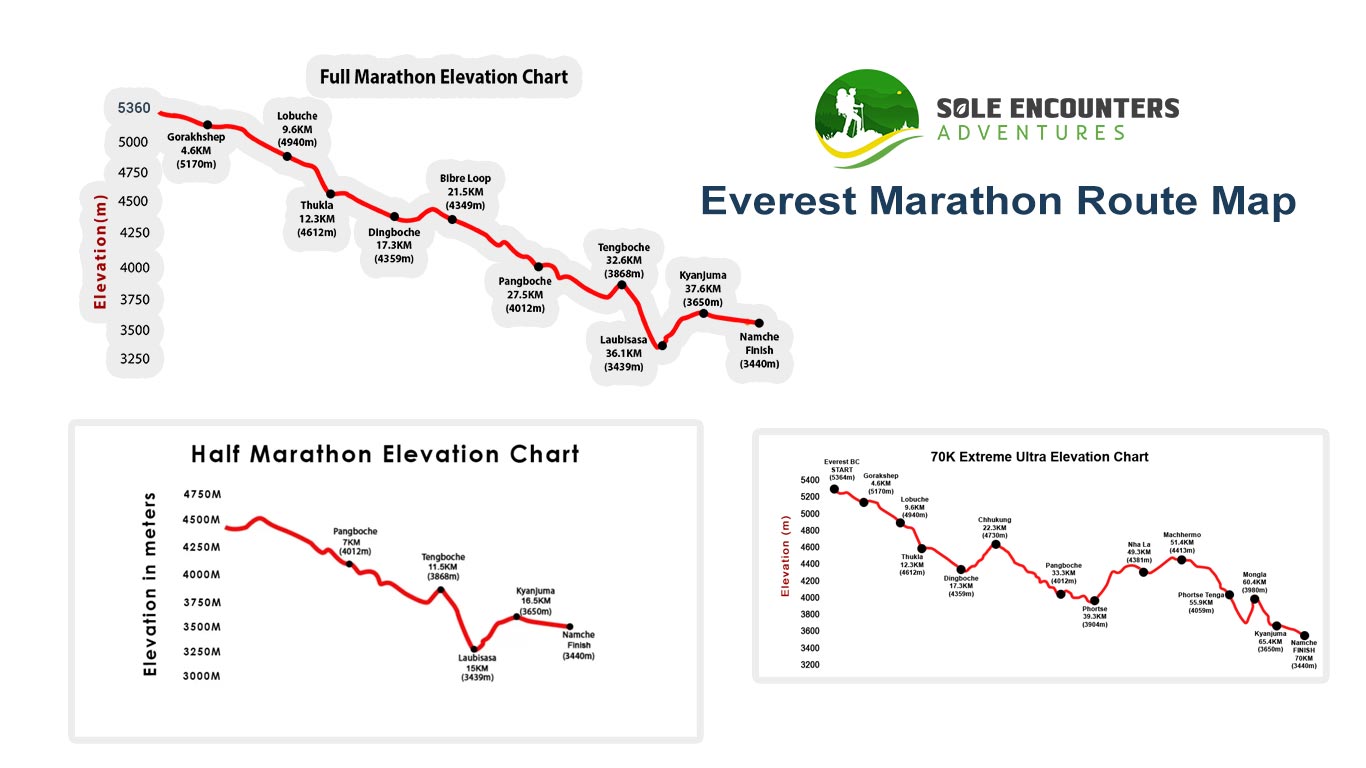
Adim Subedi
BahrainEverest Base Camp
11th August, 2024
test
Jeson
AustriaThe Trek to Base Camp
11th April, 2025
The toughest, wildest, most breathtaking run of my life and I’d do it again in a heartbeat Taking on the Everest Marathon was a bucket list dream - and Sole Encounters made that dream not only possible but absolutely unforgettable. From the moment I landed in Kathmandu, the Sole Encounters team had every detail perfectly dialed in. The logistics of getting a group up to Everest Base Camp are no joke - flights, permits, acclimatization hikes, food, gear - but they handled it all like seasoned pros. I felt safe, supported, and totally ready for the big day.
Sarah
ArmeniaAdventurer’s
29th July, 2025
Running the Everest Marathon was truly a once-in-a-lifetime experience. The views of Everest and the surrounding Himalayas were breathtaking, and the challenge of high-altitude running pushed me beyond my limits. The organization was seamless, and my guides from Sole Encounters Trekking made the whole journey smooth and enjoyable. I’ll never forget this adventure!
Rajesh
IndiaConquering My First High-Altitude Marathon
7th September, 2025
I had never run a marathon at such an altitude, and I was nervous at first. But thanks to the careful planning and support from the trekking team, I completed the 42K marathon. The sense of achievement and the friendly international atmosphere made it one of the best experiences of my life.
Emily
CanadaThe Ultimate Ultra Challenge
7th September, 2025
The 70K Ultra Marathon was the ultimate test of endurance. Every step from Everest Base Camp to Lukla was a mix of thrill, exhaustion, and awe at the Himalayan scenery. This marathon is not for the faint-hearted, but the sense of accomplishment at the finish line is indescribable. Highly recommended for serious adventure runners!
Lobsang
NepalCultural Immersion While Running
22nd June, 2025
Participating in the Everest Marathon is more than running—it's experiencing the Sherpa culture, visiting monasteries, and seeing villages along the route. Even as a local, running this marathon gave me a new appreciation of our mountains and heritage. An unforgettable adventure!
Hannah
AustraliaAdventure of a Lifetime
7th September, 2025
From registration to the finish line, everything about the Everest Marathon was amazing. The logistics, trekking support, and breathtaking trails made it both challenging and safe. Completing the world’s highest marathon is an achievement I will treasure forever. A must-do for any serious runner or adventurer!